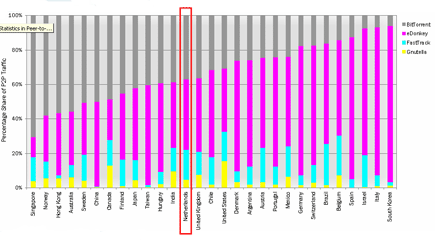Today, almost two years later, people are still quoting the “one third” statistic. But the question is.. should they?
There is no reason to believe that BitTorrent traffic has decreased. On the contrary, today, there are at least 3 popular BitTorrent sites among the 1000 most popular sites on the internet, and even more in line to enter.
But on the other hand, there are more p2p networks that continue to grow, and new video streaming sites, that cause a lot of traffic. So is it fair to say that BitTorrent is still responsible for 35% of all internet traffic?
The famous Study
Let’s start of with the original study that reported that BitTorrent was causing that much traffic.
The study by Cachelogic reports the following (June 2004):
This indeed means that BitTorrent accounted for 33% of all internet traffic in the first half of 2004.
However, there is some geographical variation.
P2P traffic in 2005
Now let’s compare this data with a more recent study by Cachelogic (January 2006):
This study reports that p2p traffic continued to grow, even relative to the other internet traffic. Januari 2006 p2p traffic acounted for approximately 71% of all internet traffic.

However, the same study shows that the marketshare of BitTorrent decreased. It seems that the eDonkey network took over the lead in most countries.
If we take a look at the US for example, we see that BitTorrent accounts for about 30% of all p2p traffic. If we assume that 71% of all internet traffic is p2p related, “only” 21% would be caused by BitTorrent. On the other hand, more than 35% of all internet traffic in the US is generated by the eDonkey network.
This means that eDonkey is generating significantly more traffic than BitTorrent. This is quite surprising. In general most people believe that BitTorrent is bigger than eDonkey. For example, the respectable filesharing news site Slyck reported this week:
Although BitTorrent would soon become the largest file-sharing network in terms of bandwidth consumption, eDonkey2000 never faded away.
However, it seems that eDonkey is generating more traffic than BitTorrent in most countries. Take the p2p market-share in China, Taiwan, and South-Korea for example, three countries with the most broadband subscribers apart form the US.
China: 50% BitTorrent / 50% eDonkey
Taiwan: 41% BitTorrent / 57% eDonkey
South Korea: 5% BitTorrent / 92% eDonkey
In Conclusion
The latest p2p traffic analysis by Cachelogic doesn’t give a definite answer to the question how much percent of all internet traffic is generated by BitTorrent. It is unlikely that it is as high as it was in 2004. To reach 35% mark, BitTorrent should be at least responsible for 50% of the p2p traffic, and it isn’t.
My guess would be, based on the p2p traffic graph that BitTorrent is responsible for approximately 35%, eDonkey for 45%, and other networks for 20% of the p2p traffic. This would mean that BitTorrent accounts for 25% of all internet traffic, and eDonkey for 32%.
However, this analysis is based on data that was gathered in 2005, so it is likely that the percentages are totally different today. Not only the market share of the different p2p networks, but also the rise of video-streaming may affect these statistics. Youtube for example indexes over 45 terabytes of video.
“one third of all Internet traffic” might still be very close to reality, but we should use this catchy phrase with caution, and be aware of regional variation.






